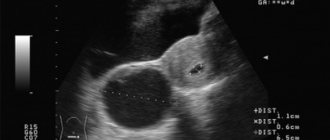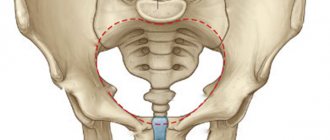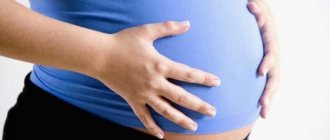Pregnancy can safely be called a time of great changes in the body of the expectant mother. From the moment of conception and as the fetus develops, significant changes occur affecting all life systems and organs, tissues and the body as a whole. These changes also affect the muscles, primarily the smooth muscles that line the uterus, the walls of blood vessels, the intestines, surround the eye and hair follicles.
Some groups of smooth muscles seem to relax during pregnancy. For example, relaxation of the smooth muscles of the arteries is necessary to dilate blood vessels and reduce pressure - this ensures an increased flow of blood, and with it oxygen and nutrients, to the placenta. The smooth muscles of the intestines, in turn, also relax, thanks to which the mother, and with her the baby, receives more useful substances from food.
During pregnancy, significant changes occur in the abdominal muscles - the so-called rectus muscles, which run from the ribs to the pubic bone. Before pregnancy, the rectus abdominis muscles, which belong to the group of skeletal muscles, formed the abs, but now they support the uterus. Skeletal muscles, including the rectus abdominis, are forced to support and move much more weight during pregnancy than before. And if a woman neglected physical exercise before pregnancy, her skeletal muscles are less elastic, and therefore the risk of injuries and sprains increases. In order to avoid injuries and sprains, it is necessary to devote time to special stretching and strength exercises.
The load on the back muscles also increases during pregnancy. The fact is that as the fetus develops, the mother’s center of gravity changes, and therefore her usual body position. If the back muscles were not strong enough before pregnancy, during pregnancy the pregnant woman's posture may change and her back may often hurt. The only way out of this situation is to develop a muscle corset even before pregnancy: you cannot pump your back muscles in a position, you are only allowed to keep them in good shape.
It is known that in parallel with the development of the baby in the womb, the weight of the pregnant woman also increases - accordingly, the load on the leg muscles increases. It is not uncommon for pregnant women to experience cramps in the calf muscles. In order to prevent swelling and varicose veins, you can again use gymnastics for pregnant women, which includes exercises for the leg muscles. Cramps of the calf muscles, in turn, occur in pregnant women as a result of a lack of essential vitamins and microelements - calcium, magnesium, potassium, vitamin D, E and others. In the last stages of pregnancy, in the last trimester, cramps of the calf muscles can be provoked by varicose veins or inferior vena cava syndrome.
When talking about muscles during pregnancy, one cannot help but think about the chest muscles. While carrying a baby, under the influence of hormones and in preparation for breastfeeding, the breasts increase in size. Accordingly, the load on the pectoral muscles increases. Special gymnastics will help to avoid breast sagging and maintain its shape - and it is advisable to perform exercises to strengthen the pectoral muscles even before pregnancy.
Is it possible to pump up abs during pregnancy?
Abdominal training during pregnancy is not a mandatory procedure; moreover, sometimes due to disorders in a woman’s body or poor physical fitness, it is worth abstaining from such training. The exact answer to the question can be given by the attending physician, after a thorough examination and analysis of the birth process, as well as by a professional trainer for pregnant women. If before pregnancy a woman regularly exercised, worked out her abs and followed a certain sports regimen, then she can also work out her abs while carrying a child, but in a lighter form. But, it should be remembered that swinging the lower abs while lying down is strictly prohibited! The practice of regular abdominal workouts for pregnant women involves doing exercises while sitting on a chair, gradually raising your legs up.
Physical activity during pregnancy is one of the factors for the success of having a healthy and strong baby. You just need to strictly follow the prescribed sets of exercises and the advice of fitness trainers for pregnant women, because only they can choose the right load without risk to the baby.
Pathological causes
In some cases, there is a pathology that develops due to certain circumstances. There is no need to worry about it ahead of time. It is necessary to initially undergo an examination, take tests, and only after collecting an anamnesis, treatment is prescribed based on the diagnosis established by the doctor.
Most often, pain caused by pathological diseases occurs against the background of the presence of chronic diseases in the mother’s body, during infection or after a viral illness. Therefore, it is recommended to carry out vaccination procedures against common diseases before conception.
Abdominal pumping in early pregnancy
Early pregnancy is the most risky period for the baby's development. The 2nd and 3rd weeks of pregnancy are the most dangerous and susceptible to disturbances and stress. Accordingly, any physical activity during this period should be stopped, since even with the least amount of stress, the risk of miscarriage increases. That is why abdominal exercises in the early stages of pregnancy are strictly contraindicated.
Particular attention should be paid to the body's reactions to any load (long walking, walking up stairs, etc.). If you experience the slightest shortness of breath or increased heart rate, you should immediately stop physical activity and give the body a rest.
Any exercises with jumping, vibrations (oriental dancing), exercise bikes and abdominal swings should be excluded for a very long period. The best option for replacing habitual exercises would be yoga and gymnastics for pregnant women, designed specifically for pregnant women. And, of course, do not forget about walks in the fresh air, which are useful at any stage of pregnancy.
Causes of muscle pain in pregnant women
A woman, being in a special position, often begins to feel completely new sensations that were previously unknown to her. Not all expectant mothers suffer from absolutely all the unpleasant signs of pregnancy (for example: toxicosis, drowsiness, loss of strength, absent-mindedness, muscle soreness in different body groups, lack of appetite, etc.), but most often at least one “illness” accompanies a woman, although would be a third of the entire period. One of the most common symptoms is muscle pain.
Abdominal pumping in late pregnancy
If you are determined to maintain muscle tone during pregnancy and your doctor has not forbidden you from light physical activity, then you should remember that abdominal exercises and any fitness activities, even light ones, should not be done throughout the entire period of bearing a child. It is necessary to take breaks during critical periods of the baby's development in the womb. Such periods include 2-3 weeks of pregnancy, as the most risky for further development or termination; 12-13 weeks, 20-24 weeks of baby development, and also 28 weeks. On such days, you should not only completely avoid physical activity, but also try not to expose your body to unnecessary emotional stress.
In general, abdominal exercises and any other mild physical activity in late pregnancy are acceptable. The only condition is to stop activity if symptoms such as headache, swelling, shortness of breath, poor circulation or pain occur.
If before pregnancy you were professionally involved in sports, then it is quite possible to continue such activities as gymnastics, athletics, cycling on a straight road, mountain climbing and yoga while carrying a baby, but it is worth reducing the load and choosing more comfortable shoes and clothes. When playing sports, you should monitor your pulse; if it exceeds the norm (for women in the position, it is equal to 140 beats per minute), exercise should be stopped immediately.
As we see, abdominal exercises and other physical activities during late pregnancy are possible, but they must be treated with extreme caution.
Physiological reasons
The human body has a developed muscular and ligamentous system, which adapts to certain characteristics in the body. Since pregnancy is a full-scale restructuring of all organs and systems, physiological pain naturally occurs during the period of bearing a baby.
Some muscles relax, others contract, but, in any case, such changes do not go unnoticed. Painful sensations in muscles, tendons, and internal organs begin from the first days of conception against the background of hormonal changes.
There are several reasons for such changes:
- The increasing level of progesterone creates the necessary conditions for the baby to grow inside the mother’s body and prepares the breasts. But, one of the conditions for change is the relaxation of smooth muscles, which also line the surface of the uterus. This is necessary so that the reproductive organ does not reject the fetus prematurely, and the walls of the blood vessels better withstand the load during blood transportation.
- Activation of estrogen occurs against the background of stimulation of uterine growth. The increased amount of the hormone is due to disturbances in the electrolyte and water-salt balance (dehydration, excess fluid). It is these changes that provoke the formation of muscle pain.
- The hormone relaxin, which is released from the first days, also prepares the body for childbirth. It helps soften the ligaments, pelvic bones, and tendons, which is extremely important for the successful passage of the child along the paths during childbirth. Naturally, such complex changes are accompanied by pain, including in the abdomen.
The musculoskeletal system becomes weak during pregnancy, so it is recommended not to make sudden movements, which can cause cramps and pain..
The most common manifestations of pain in the later stages are pressing or aching tolerable pain in the pubic area. When the pubic bones come together, pain occurs in various places. Most often, a pregnant woman feels them in the 8th month; pain symptoms often appear in the 6th month. There is no need to worry about this.
The heart muscle in pregnant women thickens significantly for the reason that at this moment it needs to pump up to 6-7 liters of blood, with the norm being up to 5.5.
If your abs hurt during pregnancy
It also happens that the abs can hurt during pregnancy and in the absence of physical activity. Such pain can occur at any stage of pregnancy, regardless of the physiological data of the expectant mother. If the pain is tolerable and insignificant, and the period is short, then there is no need to panic, perhaps your tummy is simply going to grow and thus tone the muscles. If at the same time you feel a dull nagging pain in the lower abdomen, as during menstrual periods, this is already a reason to worry.
Such pain may be a symptom of uterine tone. This disorder is characterized by increased tension in the muscles of the uterus in pregnant women. Increased tone can cause premature birth or miscarriage if the pregnancy is still very short, so you should be extremely careful with such pain.
The disease can be caused by a stressful situation, lack of proper rest and sleep disturbances, strong physical exertion on the body of the expectant mother, bad habits (smoking, frequent use of alcohol).
Uterine hypertonicity is a fairly common diagnosis in gynecological practice and in itself is quite safe. But if bloody discharge, severe pain and fever are added to it, then you should sound the alarm and immediately consult your doctor.
Therefore, all expectant mothers are advised to reduce physical activity, get more rest and get rid of bad habits in order to avoid pain in the upper and lower abs and prevent uterine tone.
Diseases that cause pain in the abdominal muscles
In a number of situations we are talking about pain symptoms caused by diseases of the digestive system. There may be several reasons for the formation of such a pathology, but in any case, control by a doctor is important, who will be able to timely distinguish a progressive dangerous condition from a physiological condition.
Acute appendicitis
While waiting for a baby, a woman must listen to the changes in her body. Reluctance to visit a doctor when signs of appendicitis appear provokes dangerous clinical consequences.
For a baby, an indifferent attitude means the risk of oxygen starvation, premature placental abruption, and death. For a woman, there is a risk of developing intestinal obstruction, infection in the peritoneum, blood loss, and shock. If the appendix ruptures, an emergency caesarean section is performed, even if the pregnancy is quite short.
When pregnant, the risk of developing appendicitis increases by 15%.
Depending on the stage of development of the process of inflammation of appendicitis, there are risks:
- The first stage is catarrhal, characterized by inflammation of the appendix. Painful symptoms in the navel area, nausea, vomiting. Long-term pain during inactivity – 6-12 hours.
- The second phlegmonous stage - complications in the form of destruction of appendage tissue, the formation of ulcers, and accumulation of pus. Aching pain radiates more to the right side, body temperature rises to 38°C*. The duration of the stage until the next stage of development is 12-24 hours.
- Necrosis of the walls of the appendix, rupture - gangrenosis. A characteristic feature of this stage is the weakening of pain symptoms in the absence of movement. The unpleasant sensations subside, but appear to a more aggressive degree when sneezing or moving. Duration - 24-48 hours.
- The fourth period is death after rupture of the appendix, inflammation or peritonitis, since the contents of the appendix enter the abdominal cavity.
Umbilical hernia
An umbilical hernia occurs in 25% of women during pregnancy. At the same time, there is a tendency to increase the risk of hernia formation in thin and short women. This feature is due to the fact that there is weak muscle extensibility in the abdominal area, and during pregnancy there is increased pressure on the organs.
This process cannot be treated; you can only temporarily use special support bandages, which are recommended for use after childbirth until complete recovery. The pain is not acute, but constant and aching. A woman notices changes in herself, but there is no need to worry about this if you seek help in a timely manner and use prevention methods.
Risk of miscarriage
The threat of miscarriage remains at any stage of gestation, but, in most cases, this trend persists in the later stages, when the baby is being formed according to the resulting genotype. If the fetus grows after 14 weeks, the risk of abortion is significantly reduced by almost three times.
However, if:
- abdominal pain radiating to the groin;
- vaginal discharge with uncharacteristic changes in the mammary glands;
- cramping abdominal cramps that increase;
- soreness in the back, aching pain in the lower abdomen.
It's worth asking for help. It is possible that placental abruption has begun, which is triggered by stress, hormonal deficiency, living conditions and insufficient intake of vitamins by the body.
Placental abruption
Detachment of a child's place is a dangerous condition, regardless of the stage of pregnancy. Without this organ, the development of a child is impossible, but even a partial dysfunctional disorder provokes complications, such as hypoxia and starvation in utero.
Painful symptoms in this case are observed according to the type of contractions that begin, the same in intensity and characteristic manifestations. It is treated with hormone replacement therapy and bed rest. Often a pregnant woman cannot even get out of bed.
Abdominal exercises during pregnancy
Exercises for pregnant women were created in order to maximally prepare expectant mothers for bearing a baby and the birth process. Following simple recommendations and completing the complex will help you keep your abs toned and stay in shape even during a period such as pregnancy.
Exercises to perform in the first stages of pregnancy (up to the 16th week):
The main task of exercises during a short period of pregnancy is to prepare the abdominal muscles for bearing a baby.
- Exercise 1: Slow walking in place or in a circle. The main thing is to keep a moderate pace and breathe correctly during the exercise.
- Exercise 2: We walk and raise our knee high in front of us. We perform the movement for 30-45 seconds.
- Exercise 3: We walk and sweep the shin back. We perform the exercise for no longer than 20 seconds.
- Exercise 4: Starting position: one arm is raised up, the other is held at the waist, feet shoulder-width apart. We bend in different directions 4-8 times.
- Exercise 5: Forward Bends. We place our feet shoulder-width apart and put our hands behind our heads. We bend forward, and at the moment of tilting, we stretch our arms straight.
- Exercise 6: Lie on your back. You can perform such exercises only if the pregnancy is progressing normally. We spread our legs bent at the knees, put our hands behind our heads, but do not close them. Slowly raise your upper body above the floor level.
- Exercise 7: Any breathing exercise. For example, take deep breaths while lying on your back.
- Exercise 8: Lie on your back. We bend our right leg at the knee and place it on the floor, and place our left leg on top of our right. Hands behind your head. We stretch our right elbow to the knee of our left leg, then do the same with our left elbow. The pace is moderate. We perform the exercise 5-8 times.
- Exercise 9: Lying on your back, stretch your arms along your body. We bend our knees. We strain our abdominal muscles and slowly straighten our legs (one at a time), sliding them along the floor, then bend them in the same way and return them to their original position.
- Exercise 10: Pelvic tilts while standing against a wall. We stand with our backs to the wall, place our feet shoulder-width apart, move our heels 30-40 cm from the wall and slightly bend our knees. Next, straining the abdominal muscles, we perform pelvic tilts, moving along the wall. You need to perform the exercise 8-10 times.
After the 16th week of pregnancy, lying on your back becomes difficult and dangerous, so such exercises should be avoided. Instead, we add exercises in a sitting position. Slowly raise your legs bent at the knees and straight to your body. As the period increases, the number of breathing exercises should be increased and the number of exercises performed should be reduced.
[5], [6]
How do abs affect pregnancy?
Well-shaped abs undoubtedly make the birth process easier. If a woman was constantly involved in sports before giving birth, then she can easily control the contraction of the abdominal muscles, and with proper breathing, she can easily give birth to a healthy and strong baby. But the role of good physical fitness does not end there.
After childbirth, a woman's skin may be susceptible to stretch marks. Inflated abs will help to avoid such a negative outcome and keep your skin as beautiful as before bearing a child. In addition, trained muscles will help you get back into shape faster after giving birth.










